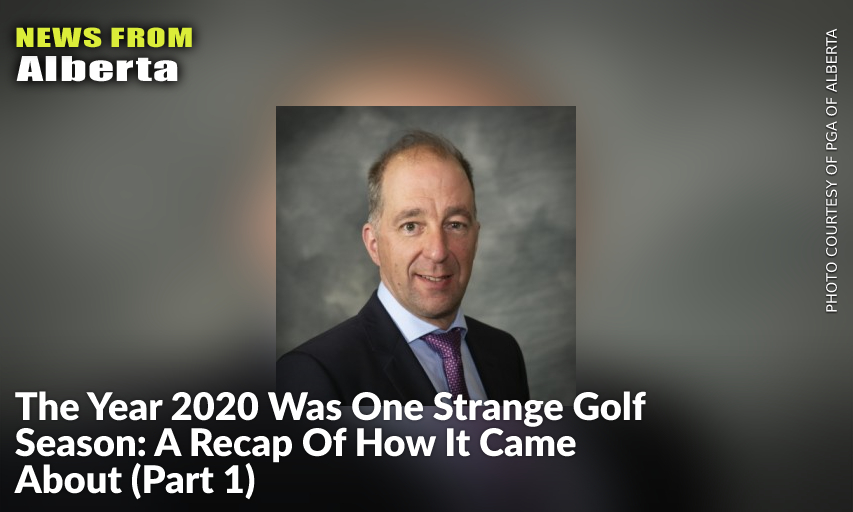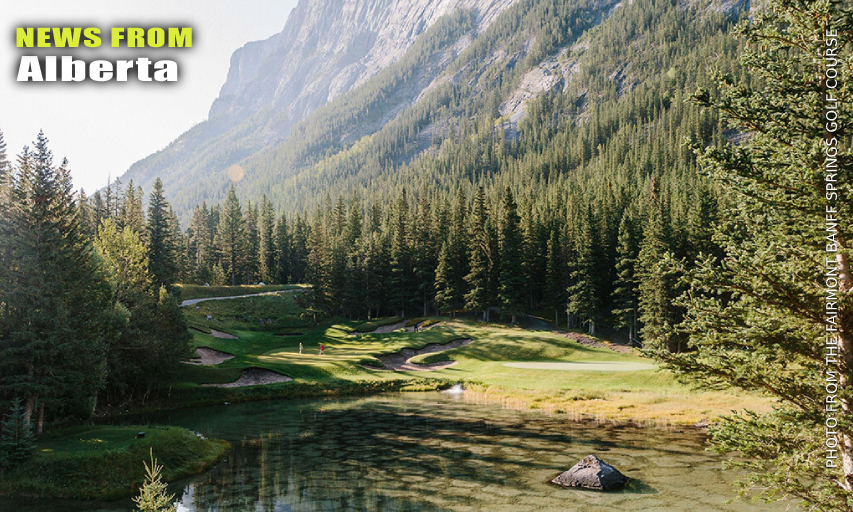The Year 2020 Was One Strange Golf Season: A Recap Of How It Came About (Part 1)
- Details
- Category: Inside Golf
- Published: 2021-01-28

By GORD MONTGOMERY, Inside Golf
CALGARY, Alberta — There’s no denying that the 2020 golf season in Alberta was a strange one. From a season that almost didn't begin, to drive-by green fee payments, no pre-round warm-up, pro shops where you could look but not touch, sanitizing hands prior to entering a facility, and slimmed down food services, the year was by any stretch a weird one. Yet, when all was said and done, the game of golf flourished thanks to the supreme work efforts of the members of the PGA of Alberta who put their hearts and souls into making the game accessible to the public.
Speaking to the trials, tribulations and turmoil of getting the past golf season up and running, the PGA of Alberta’s executive director, Robert Rousselle, said he was pleased with how his membership handled the challenges they faced. In the first of this two-part series, we’ll discuss with him the obstacles faced early on in making the provincial government realize the sport was appropriate for socially-distanced spacing and would not contribute to the growing novel coronavirus pandemic numbers.
From the get-go, the PGA of Alberta worked hand-in-hand with other provincial golf groups, including the National Golf Course Owners Association (NGCOA) and NAGA (National Allied Golf Association) through the voice of spokesperson Bruce McAllister, to lobby the Alberta government to have the sport allowed while so many other activities were shut down.However, golf for what seemed the longest time, wasn’t permitted, making that hurdle perhaps the toughest to overcome.
“I guess I’ll wear my NAGA hat in some ways,” Rousselle began. “We sat down and looked at it. We (different golf associations) all cooperate really well, work really well together. It was a group already in place so for us to look at it as to ‘What are we going to do?’ and ‘How are we going to do it? was an automatic trigger.”
That was where McAllister came in, and through his provincial legislature connections was able to sell a solution to the elected officials that in fact the game of golf was safe if certain restrictions were followed.
“We told each other that we weren’t an essential service,” which at the beginning was deemed the only businesses that could operate in Alberta. “We worked for an exemption and after that we built a strategy, with good answers, good information. We were looking at ourselves as more of a solution, promoting activities, looking at health, mental health of individuals. Looking at the impact financially, how this could help the golf industry. At the end of the day, we just wanted to be part of the solution to move the industry forward and have people playing golf.”
A key component to swaying the minds of the government was the basically unlimited space on a golf course where strict social distancing measures could be adhered to. As well, courses took extreme caution in making sure everything that was touched, including door handles (when eventually a maximum of four people were allowed in pro shops), to plexiglass barriers separating staff from customers, to sanitizing rental power and pull carts after each use, and sanitizing washroom facilities on a regular basis along with no-touch flag sticks.
“In the end, I think we came up with a really strong document that the government endorsed,” said Rousselle.
While it seemed like forever for the approval to come down the pipeline, at least to those who golf on a regular basis, this whole approval plan was done as quickly as possible, Rousselle continued. Even so, there wasn’t any sense of panic where every day counts in what is already a short golf season in many parts of the province.
“We had a process in place. It was nerve-wracking to see the industry not getting the green light after all the effort initially,” Rousselle confirmed when asked if panic was perhaps setting in and nothing seemed forthcoming as the days began to warm up and people were chomping at the bit to hit the links. “We had that process in place and we just kept working at it. Being patient. So the (April, May) weather actually helped us. We had some late storms, et cetera, and looking at dates courses opened in the past, with a couple of exceptions, we weren’t far off that target.”

Fairmont Banff Springs Golf Course
Putting The Plan Into Action
Rousselle noted that the umbrella of helper groups presented “one unique voice through NAGA,” in getting everyone in the industry in Alberta ready to roll once word came that the sport could in fact finally start.
“We needed to make sure all the PGA of Alberta courses were prepared to go and that all the documents our members were presented with were understood, that they made sense. We always had our fingers crossed that the industry would open in a good place and with good timing.”
Interestingly enough, the plan put into place wasn’t just Alberta-bound; it was in fact found to be useful across the country as other provinces saw golf swing back into action. Of that aid to others, Russell noted, “They rallied behind what we had and we didn’t mind sharing our information nationwide.”
Of course the primary focus was on Alberta courses and that was evident. “From the beginning I’d say the information from NAGA Alberta was really strong and with our members, we kept them up to date. We didn’t hide anything. We kept them up to date so they could be prepared to go once they got the green light.”
And that green light finally came, and with that provincial golf courses were flooded with players, including many who had never played before or found themselves coming back to a game long abandoned. Statistics from the National Golf Course Owners Association, on data from a 2020 season timeline of April through October, showed an increase of 22.2 per cent over the 2019 rounds played.
Rousselle said the industry members were told to open if they were ready once the go-ahead was given but to not feel pressure to do so if they weren’t fully prepared. To that end, some courses offered others a helping hand in setting up for what turned out to be a hectic season.
“The amount of work, the effort of the golf pros, the facilities, was a lot. I think where we made a really good recommendation was to have a welcome point (in parking lots). That was a very key checkpoint. Following that with everything pre-paid, you didn't have to go to the clubhouse (in the early weeks). Everything was highly focused on tee times. Following that we focused on different ways to create sales for the pro shops. I think some were really creative with virtual pro shops while others had clothing, things like that, outside. It give them a 5-star rating for what they did to be able to execute that because I didn’t hear of too many major issues. They did a phenomenal job to make sure members and guests were really well protected,” from the possibility of COVID-19 spread.
Once things got underway, the business boomed. In Part 2 of this report, we’ll look at the ways clubs handled the pandemic fears and how they handled the overwhelming demand to tee times as well as what lies ahead for the industry as the 2021 golf season approaches.



